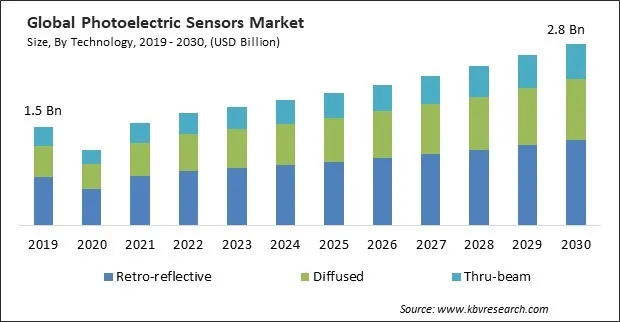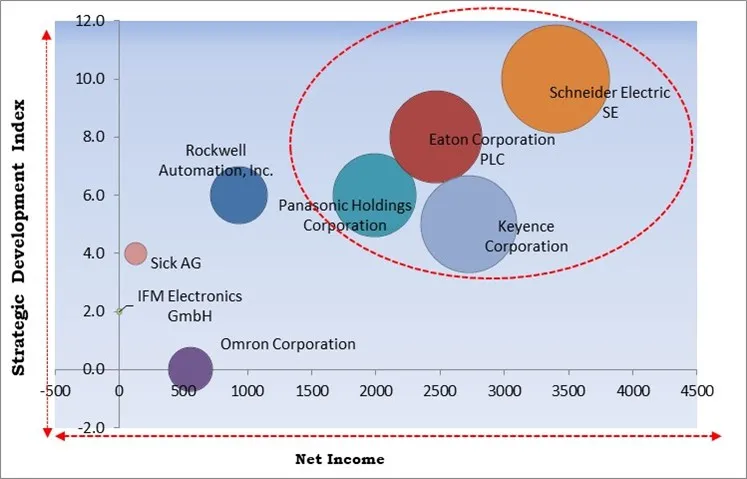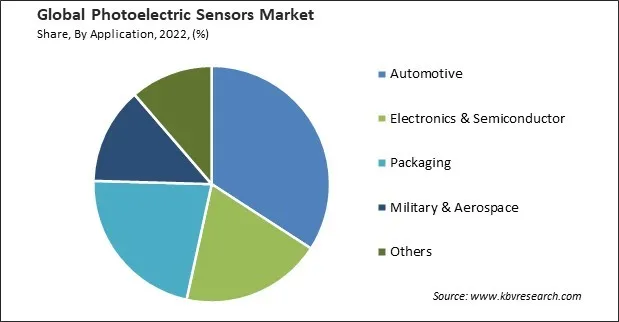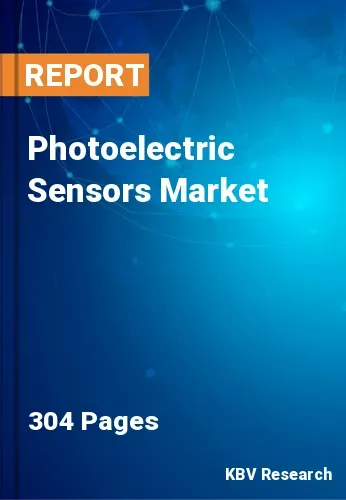The Global Photoelectric Sensors Market size is expected to reach $2.8 billion by 2030, rising at a market growth of 6.3% CAGR during the forecast period. In the year 2022, the market attained a volume of 37,495.1 thousand units, experiencing a growth of 6.2% (2019-2022).
Photoelectric sensors are widely used for object detection and proximity sensing in automotive manufacturing. Therefore, the automotive segment acquired $599.6 million in 2022. These sensors can witness the presence or absence of components on assembly lines, ensuring that the right parts are in the correct position for assembly. They contribute to automating processes, reducing errors, and improving production efficiency. These sensors are employed in adaptive lighting systems that adjust the brightness and direction of headlights based on environmental conditions. These sensors detect ambient light levels, oncoming traffic, and the vehicle's speed to optimize the illumination and enhance driver visibility.

The major strategies followed by the market participants are Partnerships, Collaborations & Agreements as the key developmental strategy to keep pace with the changing demands of end users. For instance, In, October, 2023, Sick AG teamed up with Endress+Hauser Group Services AG, under this collaboration, the companies supported the customers in the areas of resource and energy efficiency. Additionally, the collaboration assisted in protecting the climate and the environment. Additionally, In, September, 2023, Rockwell Automation, Inc. came into a partnership with Everactive, Inc., under this partnership, the solutions of Everactive were combined with the Dynamix product portfolio of Rockwell Automation.
Based on the Analysis presented in the KBV Cardinal matrix; Schneider Electric SE, Eaton Corporation PLC, Keyence Corporation and Panasonic Holdings Corporation are the forerunners in the Photoelectric Sensors Market. In, February, 2021, Keyence Corporation formed a partnership with StayLinked Corporation, under this partnership, the SmartTE software of StayLinked was incorporated into the latest mobile computer and rugged smart device, the BT-A700, of Keyence. Companies such as Rockwell Automation, Inc., Omron Corporation, Sick AG are some of the key innovators in Photoelectric Sensors Market

Smart photoelectric sensors come equipped with advanced features and capabilities beyond traditional sensors. These sensors often incorporate microprocessors, communication interfaces, and onboard processing, enabling them to perform complex tasks and adapt to dynamic environments. The advent of smart sensors aligns with the principles of Industry 4.0, with a strong emphasis on integrating digital technologies into manufacturing processes. Smart photoelectric sensors contribute to the automation of industrial processes, improving productivity, reducing downtime, and enabling more agile and flexible manufacturing environments. This integration enables advanced functionalities such as object recognition, pattern analysis, and decision-making based on the sensor's input. AI-enhanced sensors open up new possibilities for automation and intelligent systems. Thus, the emergence of smart photoelectric sensors has positively impacted the market.
Non-contact sensing eliminates the need for physical contact between sensors and objects. In industrial settings, this is crucial for ensuring equipment and personnel safety. The ability of these sensors to detect objects without direct contact contributes to implementing enhanced safety standards, leading to increased adoption in manufacturing environments. In industries where handling delicate materials is common, non-contact sensing with these sensors prevents damage to these materials. This is particularly important in applications such as electronics manufacturing, where precise and gentle handling of components is essential to avoid defects. They suit diverse applications across industries, from detecting transparent objects to identifying irregular shapes. Due to the increasing demand for non-contact sensing, the market is expected to expand.
Harsh industrial environments, such as high dust, moisture, vibrations, or temperature extremes, are common in manufacturing plants and facilities. The inability of these sensors to operate effectively in these conditions limits their adoption in critical industrial applications. Industrial automation and control systems heavily rely on sensors for precise and reliable operation. The inability to operate in harsh environments can disrupt manufacturing processes, leading to inefficiencies, production delays, and potential quality issues. Harsh environments are prevalent in construction and mining operations, where sensors are exposed to dust, debris, and rugged terrain. The inability to withstand these conditions limits the applicability of photoelectric sensors in these industries. Photoelectric sensors that cannot withstand these conditions may face limitations in applications such as traffic monitoring and vehicle detection. Due to the above-mentioned factors, the market is expected to decline in the coming years.
Based on application, the market is fragmented into automotive, packaging, electronic & semiconductor, military & aerospace, and others. The electronic & semiconductor segment projected a prominent growth rate in the market in 2022. These sensors precisely detect semiconductor wafers as they move along conveyor systems. These sensors ensure accurate positioning and movement control during various stages of semiconductor manufacturing processes. In semiconductor manufacturing, these sensors detect the position and alignment of lead frames. This is crucial for ensuring that the semiconductor chips are accurately mounted and bonded to the lead frames during packaging.

On the basis of technology, the market is segmented into retro-reflective, diffused, and thru-beam. The diffused segment acquired a substantial revenue share in the market in 2022. Diffused sensors find applications in various industries, including manufacturing, packaging, and logistics. Their versatility and ease of use make them a go-to choose for many automation scenarios. Diffused sensors often feature a compact and space-saving design. This makes them suitable for installations where available space is limited or where a discreet and unobtrusive sensor solution is preferred. The integrated design of diffused sensors reduces the components required, making them a cost-effective solution. The absence of a separate reflector or receiver unit contributes to overall cost savings in terms of both equipment and installation.
| Report Attribute | Details |
|---|---|
| Market size value in 2022 | USD 1.8 Billion |
| Market size forecast in 2030 | USD 2.8 Billion |
| Base Year | 2022 |
| Historical Period | 2019 to 2021 |
| Forecast Period | 2023 to 2030 |
| Revenue Growth Rate | CAGR of 6.3% from 2023 to 2030 |
| Number of Pages | 304 |
| Number of Tables | 553 |
| Quantitative Data | Volume in Thousand Units, Revenue in USD Billion, and CAGR from 2019 to 2030 |
| Report coverage | Market Trends, Revenue Estimation and Forecast, Segmentation Analysis, Regional and Country Breakdown, Competitive Landscape, Porter’s 5 Forces Analysis, Company Profiling, Companies Strategic Developments, SWOT Analysis, Winning Imperatives |
| Segments covered | Technology, Application, Region |
| Country scope |
|
| Companies Included | Omron Corporation, Panasonic Corporation, Rockwell Automation, Inc., Eaton Corporation Plc., Keyence Corporation, Schneider Electric SE, Autonics Corporation, SICK AG, Balluff GmbH, and IFM Electronic GmbH |
| Growth Drivers |
|
| Restraints |
|
Region-wise, the market is analysed across North America, Europe, Asia Pacific, and LAMEA. In 2022, the Asia Pacific region registered the highest revenue share in the market. The expansion of safety regulations in developing nations such as Japan, China, and India, as well as the implementation of IIoT in industrial facilities, all contribute to the expansion of photoelectric sensor production in the region. The rapid expansion of end-user sectors such as consumer electronics, automotive, textile, and industrial is substantially driving the growth of the market because the data collected by the sensors can be immediately compiled and implemented to enhance the efficiency of manufacturing processes.
Free Valuable Insights: Global Photoelectric Sensors Market size to reach USD 2.8 Billion by 2030
The market research report covers the analysis of key stake holders of the market. Key companies profiled in the report include Omron Corporation, Panasonic Corporation, Rockwell Automation, Inc., Eaton Corporation Plc., Keyence Corporation, Schneider Electric SE, Autonics Corporation, SICK AG, Balluff GmbH, and IFM Electronic GmbH.
By Technology (Volume, Thousand Units, USD Billion, 2019-2030)
By Application (Volume, Thousand Units, USD Billion, 2019-2030)
By Geography (Volume, Thousand Units, USD Billion, 2019-2030)


This Market size is expected to reach $2.8 billion by 2030.
Emergence of smart photoelectric sensors are driving the Market in coming years, however, Inability to operate in harsh environments restraints the growth of the Market.
Omron Corporation, Panasonic Corporation, Rockwell Automation, Inc., Eaton Corporation Plc., Keyence Corporation, Schneider Electric SE, Autonics Corporation, SICK AG, Balluff GmbH, and IFM Electronic GmbH.
In the year 2022, the market attained a volume of 37,495.1 thousand units, experiencing a growth of 6.2% (2019-2022).
The Retro-reflective segment is leading the Market by Technology in 2022; thereby, achieving a market value of $1.3 billion by 2030.
The Asia Pacific region dominated the Market by Region in 2022, and would continue to be a dominant market till 2030; thereby, achieving a market value of $1.1 billion by 2030.
Our team of dedicated experts can provide you with attractive expansion opportunities for your business.

